Travel
Ghent – Belgium Travel Guide 2022
Published
1 year agoon
By
Berry Fox
Ghent – Belgium Travel Guide 2022 You can visit Gent for a day just like in Bruges. If you want to see the city in more detail, of course, 2 days will be more comfortable.
There’s only one downside to planning a single day here; Ghent is a university city that makes it clear from the first minute with its energy that you never want to leave here. We are sure that you will love the calmness of Ghent, especially after the tourist crowd of Bruges. Since the city is flat, it can be easily visited on foot, and it is a very pleasant place in terms of eating and drinking. Have a good trip already!
Ghent – Belgium Travel Guide 2022
#1 Saint Michael’s Church:
The construction of Saint Michael’s Church began in 1440 with a two-phase plan, to be built on the site of another chapel that existed at the same place. It took so many years to complete that in the meantime, some parts of it were badly damaged, so it was demolished and rebuilt. The church was normally intended to have a tower; Come and go, when the construction was still not completed in 1828, the church was completed without a tower and opened to visitors.
The general architectural style of the church, which is made of sandstone, which you will see frequently in Gent, is Gothic and Baroque, and its interior architecture has Neo-Gothic and Baroque decorations. Its decoration includes paintings by important Flemish artists such as Anthony van Dyck from the 18th century and a copy of Michelangelo’s Madonna of Bruges by someone else.
In front of the church St. You will see the Michael Bridge. This bridge, which was built in 1905 in Neo-Gothic style, is also very valuable due to its harmony with the surrounding architecture and its contribution to the Gothic silhouette of Ghent.
Location: Sint-Michielsplein 4, 9000 Gent, Belgium

#2 Graslei & Korenlei:
Most of the places to visit in Ghent are located in the historical city center around the Leie River, which divides the city into two. While walking the most important points of Gent, you will often come to the quay area where the Leie River flows. The right section of the Leie River is called Graslei, and the left section is called Korenlei. Both areas were important ports of the Middle Ages, and are now one of the most touristic and lively areas of Ghent. Along the quay, there are all kinds of historical shops and merchant houses that serve as venues today. The general landscape is like a nostalgic postcard; one is surprised which one to study. You can visit this area by walking on the quay around the canal or by joining the canal tours with boats. You can find the details about the Gent canal tour in the continuation of the article.
Locaation: Korenlei, 9000 Gent, Belgium
Ghent – Belgium Travel Guide 2022
#3 Saint Bavo’s Cathedral:
Saint Bavo’s Cathedral, one of the landmarks of Ghent, was completed in 942 and located in the same place, St. John the Baptist Church took its present form with the additions that started in 1274. Like many buildings in Ghent, St. Bavo’s Cathedral is also in Gothic style. The magnificence of Saint Bavo’s actually comes from its 89-metre length, itself one of the most magnificent spots in the city.
It is of particular importance for Ghent that the cathedral hosts The Adoration of the Mystic Lamb painting by Hubert and Jan van Eyck, one of the most valuable works of the Northern Renaissance period and Belgium. Adoration of the Mystic Lamb is among the oldest oil paintings in the world. Other works by Flemish artists are also displayed in the cathedral.
st. Bavo’s Cathedral is located on Sint – Baafsplein, one of the main squares of Ghent. In this square, St. In addition to Bavo’s Cathedral, you will also see the Belfort bell tower and the Royal Dutch Theater building. There is a place called Achtersikkel 100 meters ahead of the square. This Renaissance-era building with its two round towers takes its name from the Sickelen family, who was among the wealthiest in the city at that time and owned the houses here. As the Achtersikkel is used as the Ghent conservatory today, you can hear the students’ work while walking in its courtyard.
Location: Sint-Baafsplein, 9000 Gent, Belgium

#4 Belfort van Gent:
The Belfort bell tower, whose construction was completed in 1380, is located in Ghent’s St. Nicholas Church and St. It is one of the three tallest structures along with Bavo’s Cathedral. The bell tower, which symbolizes the independence of the city and undertakes the duties of announcement, observation and defense, is 91 meters long and is under the protection of UNESCO. The bell tower is open every day from 10:00 to 18:00, the entrance fee is €8. Free for those with City Card Ghent.
The rectangular building right next to Belfort was completed in 1445 as Cloth Hall, or Cloth Exchange. It took 1903 for the hall to take its original form, but even as it was opened, it became the center of the textile trade of Ghent in the Middle Ages. Mammelokker, which was added between Cloth Hall and Belfort, was built as an entrance to the city prison.
Location: Sint-Baafsplein, 9000 Gent, Belgium

#5 Korenmarkt:
The old wheat market of Gent, Korenmarkt, is located on the Leie River and St. Nicholas Church. Korenmarkt is one of the most touristic spots in Ghent today, with dozens of cafes and restaurants serving in historical architecture, just like in the quay area. Connecting the city’s famous shopping streets, Veldstraat and Kortemunt, this square was once the city center of Graslei and Korenlei.
It was used as a place where the wheat brought from its mother was sold.
Location: 9000 Ghent, Belgium
Ghent – Belgium Travel Guide 2022
#6 Nicholas Church:
One of our favorite architectures in Gent, St. Nicholas Church! Like other religious buildings of Ghent, this one was built on an existing church. st. Nicholas Church is said to have lasted throughout the 13th century, and judging by the result, we can say that it was worth it at the highest level possible. What makes this church one of our favorites in Ghent is that it is finished with a special blue stone brought from the Tournai region.
Tournai is located in the Scheldt region, which includes Ghent, and the name of this region comes from the Scheldt River. Thanks to this blue stone used in its construction, St. Nicholas Church is considered one of the best examples of the Scheldt Gothic architectural style. If you haven’t heard before, the most important details of the Scheldt Gothic style include the blue stone of the Tournai region, the single tower rising in the middle of the church, and the slender cylindrical towers at the corners of the architecture. The church is open to visitors between 10:00 and 17:00 every day except Mondays. It can be visited between 14:05 and 17:00 on Mondays. Entry is free.
Location: Cataloniëstraat, 9000 Gent, Belgium
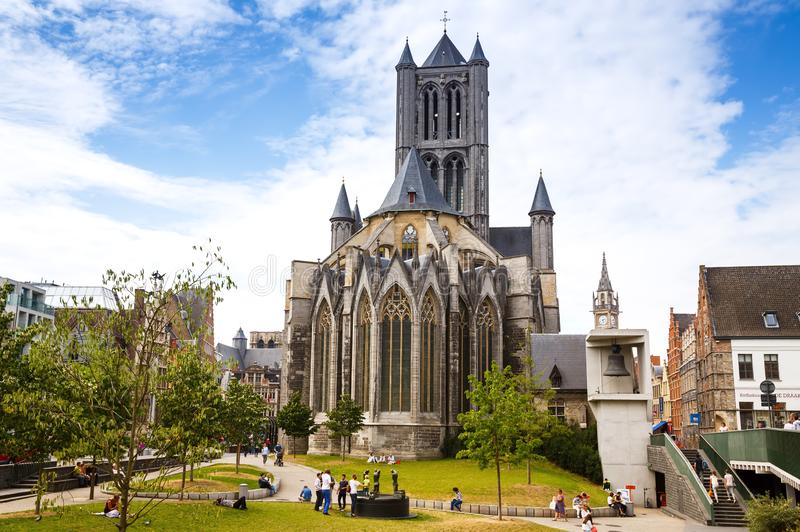
#7 Gravensteen:
Of course, there would be a castle that you should see in Ghent, where you will feel the Middle Ages! Castle of the Counts, translated into Turkish as Counts Castle, is located on the banks of the Leie River. Built in 1180, the castle was used as the residence of the counts of Flanders until the 14th century. It is a building that was renovated several times until it was opened to visitors as a museum, and was used as a court, prison and factory over time.
In the museum inside the castle, you can visit the remnants of the Counts of Flander, the stables, torture and execution rooms. Gravensteen is an important part of dynastic culture and tourism in Ghent. On some days, it also hosts wedding ceremonies and festivals. Entrance fee to the castle is €12, free with City Card Ghent. The castle is open to visitors from April to October from 10:00 to 18:00, from November to March at 09:00 to 17:00.
Location: Sint-Veerleplein 11, 9000 Gent, Belgium

#8 Patershol:
Before we started to tour Ghent, we met with an officer at the tourist office. When I asked him if he had a place to recommend other than places to visit, he said that we should definitely go to Patershol. That’s how our dear Patershol and our paths crossed. Patershol is definitely one of the most beautiful neighborhoods in Ghent with its cobblestone streets, historical authentic houses, super delicious places and hidden underground bars. The streets are a complete movie set, you really feel like you are inside the decor while walking. How this beautiful medieval texture has been preserved so well in the intervening time is another matter of curiosity!
Patershol is an artistic neighborhood mostly preferred by the intellectuals. Belgian artists live in this neighborhood with the painter; It is very possible that you will come across their workshop on the streets. Naturally, design boutiques and galleries are a must here. The traces of the Middle Ages already suit any art-related space; but one of the features that makes Patershol so famous today is undoubtedly the venues that form a gourmet route here. In Patershol, you can find many options not only for European cuisine, but also for world cuisine. And of course, traditional pubs are another alternative for those who want to try Belgian beers.
If you want to visit a museum in Patershol, you can go to the House of Alijn, where an old nursing home has been turned into a museum. The museum is entirely about the 20th century; It has a collection of objects, photographs and records of daily life.
Location: 9000 Ghent

Ghent – Belgium Travel Guide 2022
#8 Vrijdagmarkt:
Another square you can see in Ghent is Vrijdagmarkt, which means Friday Market, where the tradition of Friday market is still maintained every week. The area around the square is full of shops where tradesmen used to carry on their commercial life; Today, each of them serves as a cafe, restaurant and pub. The Friday market of Vrijdagmarkt is open between 09:00 and 13:00 in the morning. Fruit and vegetable stalls are in the majority in the market, but there are also second-hand stalls selling vintage products in some areas.
If you like to visit second-hand markets, you can go to Bij Sint-Jacobs square, 100 meters from Vrijdagmarkt. Here, too, a second-hand and antiques market is set up between 08:00 and 13:00 on Fridays, Saturdays, and Sundays.
Location: 9000 Ghent, Belgium

#9 MSK – Museum voor Schone Kunsten:
MSK Fine Arts Museum, one of the oldest museums in Belgium, hosts a large collection covering the period from the Middle Ages to the middle of the 20th century. Although the collection is generally shaped by the works of Flemish artists, it is possible to find examples of European art, especially the works of French painters. As of 2020, MSK will also host the An Optical Revolution collection, which consists of important works by Jan van Eyck. Entrance fee to the museum is €6, free with City Card Ghent.
Location: Fernand Scribedreef 1, 9000 Gent, Belgium

#10 SMAK – Municipal Museum of Contemporary Art:
Opened in 1999, SMAK Museum of Modern Art has a collection of modern and contemporary works of art after 1945. It also features world-renowned modern art works, mainly by Flemish artists. Its temporary exhibitions are renewed every 4 months, it is one of Belgium’s home favorite museums. Entrance fee to the museum is €12, free with City Card Ghent.
Location: Jan Hoetplein 1, 9000 Gent, Belgium
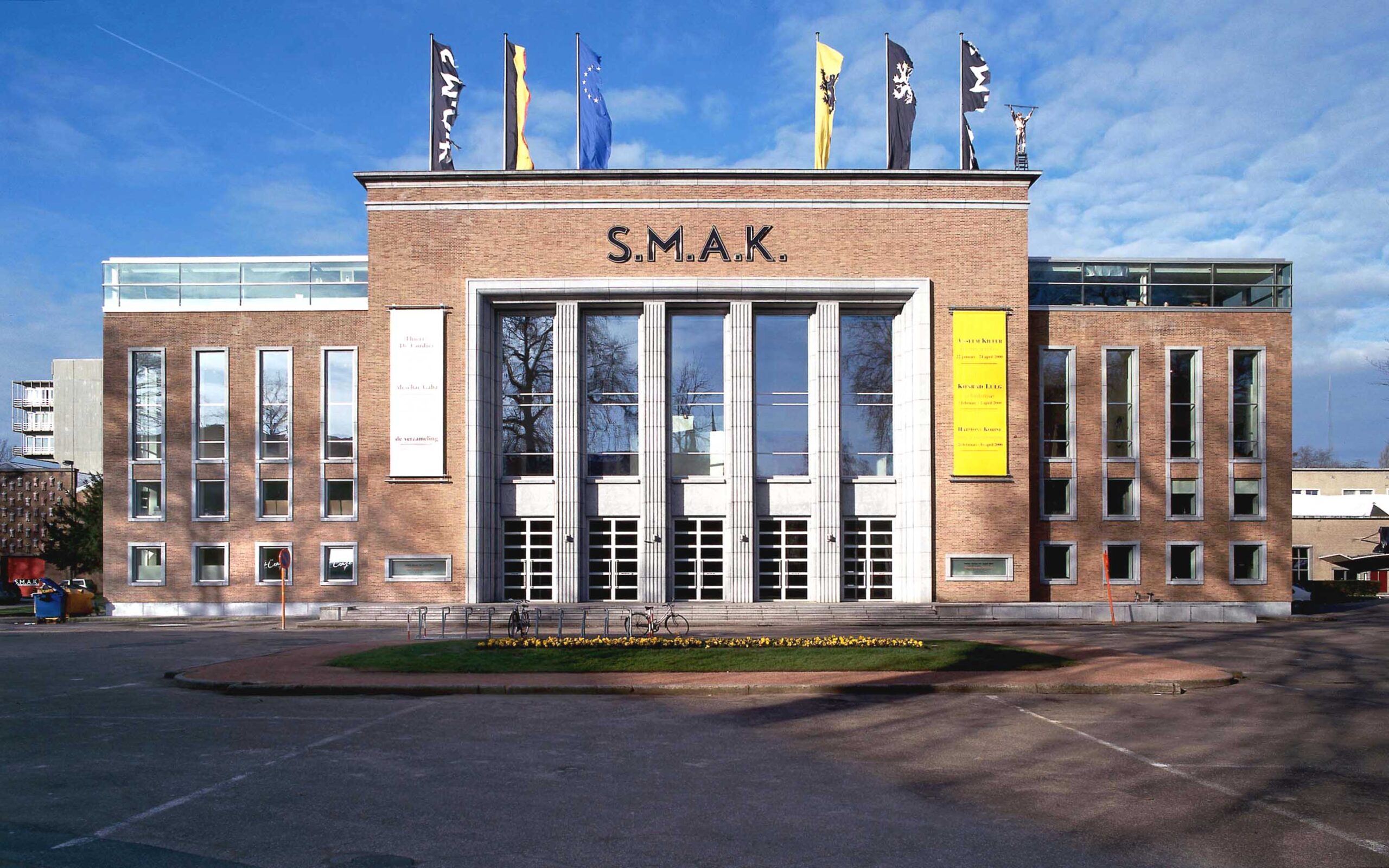
#11 STAM – Stadsmuseum Gent:
Opened in 2010, the City Museum of Ghent is the kind of museum that those who want to learn about the history of the city willlove. In the museum, which dates back to the 1800s, when the city was started to be established in general, you can examine the process of Ghent until today, both with the remains and objects collected from the Ghent environment, and with interactive presentations. STAM City Museum, which is extremely modern with old maps, animations and photographs, is also very enjoyable for children. Entrance fee to the museum is €8, free with City Card Ghent.
Location: Godshuizenlaan 2, 9000 Gent, Belgium

#12 Old St. Elizabeth Beguinage:
One of Ghent’s three Beginjhof settlements, St. Elizabeth Beguinage, like its examples in other cities, is a living complex built for women who belong to the Beguinages order and will not marry for religious reasons. In the Beguinages, which are seen as a kind of retreat, women have the chance to live safely and self-sufficiently.
Founded in 1242, St. The Elizabethan Beguinage used to be walled and is no longer so. The most important feature is that there are 4 churches around it: Roman Catholic, Orthodox, Protestant and Anglican. For this reason, it is also known as the Holy Corner.
Location: Groot Begijnhof 67, 9040 Gent, Belgium

Travel
Exploring Amsterdam’s Best Laptop-Friendly Cafés for Digital Nomads
Published
8 months agoon
24/08/2023By
Berry Fox
Amsterdam, renowned for its picturesque canals and vibrant cultural scene, has become a haven for digital nomads seeking a balance between work and exploration.
The city’s charming coffee culture, coupled with its tech-savvy ambiance, has given rise to a plethora of laptop-friendly cafés that cater to the needs of remote workers. This article serves as a guide to some of the best laptop-friendly cafés in Amsterdam, where you can sip your favorite brew while staying productive.
Exploring Amsterdam’s Best Laptop-Friendly Cafés for Digital Nomads
1. Coffee & Coconuts
Nestled in a former cinema, Coffee & Coconuts is a spacious and aesthetically pleasing café that offers a tranquil atmosphere for those seeking a productive work environment. With three levels of seating options, including cozy corners and communal tables, you can easily find your perfect spot. The café’s ample power outlets, free Wi-Fi, and a menu featuring an array of coffee options, fresh juices, and healthy dishes make it a top choice for digital nomads.

2. The Hoxton
Located along the Herengracht canal, The Hoxton is a stylish boutique hotel that boasts a welcoming lobby turned café, perfect for remote work. The ambiance blends vintage décor with modern amenities, offering a comfortable space to settle in with your laptop. The Hoxton provides complimentary Wi-Fi, a selection of delicious pastries, and a range of beverages from expertly brewed coffee to herbal teas.

3. Lot Sixty One Coffee Roasters
For the true coffee connoisseur, Lot Sixty One Coffee Roasters is a must-visit. This cozy café is celebrated for its exceptional coffee brewed from beans roasted on-site. The café’s minimalist design and serene ambiance create an ideal setting for focused work. The absence of distracting background noise further enhances its suitability for remote work. While here, savor a cup of their artisanal coffee and perhaps engage in a quick chat with the knowledgeable baristas.

4. Scandinavian Embassy
A haven for lovers of Scandinavian design and quality coffee, Scandinavian Embassy offers a sophisticated space for digital nomads. The café’s specialty coffee is crafted with precision, and the menu features an assortment of delectable treats. The minimalist interior, characterized by clean lines and natural materials, fosters a serene atmosphere, while the friendly staff ensures your caffeine fix is accompanied by a productive work session.

5. De Wasserette
De Wasserette, with its rustic charm and inviting atmosphere, seamlessly blends into Amsterdam’s cozy ambiance. Known for its artisanal bread and pastries, the café provides an inviting environment for those seeking a laptop-friendly space. The wooden tables, ample natural light, and the aroma of freshly baked goods set the stage for a productive work session, complemented by their selection of coffees and teas.

Amsterdam’s coffee culture and digital-friendly mindset have given rise to an array of cafés where remote workers can find solace while pursuing their professional endeavors. From the trendy Coffee & Coconuts to the coffee perfectionists’ haven, Lot Sixty One Coffee Roasters, each café offers a unique experience. So, whether you’re a digital nomad in search of an inspirational workspace or a traveler looking to soak up Amsterdam’s charm while catching up on work, these laptop-friendly cafés have got you covered. Embrace the blend of productivity and leisure that Amsterdam’s coffee scene has to offer.
Entertainment
Finding a Hotel for Pride 2023 in Amsterdam
Published
9 months agoon
23/07/2023By
Kenta Fox
Amsterdam Pride is one of the most anticipated and colorful events of the year, attracting LGBTQ+ travelers and allies from all corners of the world.
As you prepare for an unforgettable experience during Pride 2023 in Amsterdam, finding the right hotel is crucial to ensuring a comfortable and enjoyable stay.
1. Book Early, Secure Your Spot Amsterdam Pride is an incredibly popular event, and hotels in and around the city tend to fill up quickly. To secure the best accommodations at reasonable rates, it’s essential to book your hotel as early as possible. Keep an eye on the official Pride website and other event-related platforms for announcements and special deals on accommodations.
2. Choose the Right Location Amsterdam offers a diverse range of neighborhoods, each with its unique charm and atmosphere. For the most convenient and immersive experience during Pride 2023, consider staying in areas that are close to the event venues and parade route. The city center and the Le Marais neighborhood (also known as the Gay Village) are popular choices for LGBTQ+ travelers, as they are in close proximity to major Pride events and gay-friendly establishments.
3. Gay-Friendly Hotels: Embrace Inclusivity For an extra-special Pride experience, opt for a gay-friendly hotel that actively supports and welcomes LGBTQ+ guests. These hotels often go the extra mile to create a warm and accepting environment, allowing you to feel comfortable and free to be yourself during your stay. Look for hotels with LGBTQ+ symbols or statements of inclusivity on their websites.
4. Budget Considerations Amsterdam offers a wide range of accommodations, catering to various budgets. Before making your reservation, set a budget for your stay and explore options that align with it. Keep in mind that prices for hotels during Pride might be higher than usual due to the high demand. If you’re looking to save some money, consider staying slightly further from the city center or sharing a room with friends.
5. Amenities and Facilities Think about the amenities and facilities that are important to you during your stay. Some hotels offer on-site restaurants, bars, gyms, or wellness facilities, which can enhance your overall experience. Additionally, consider the type of room you prefer – whether it’s a standard room, a suite, or a shared dormitory for a more budget-friendly option.
6. Read Reviews and Ratings Before finalizing your hotel choice, read reviews and ratings from previous guests. Websites like TripAdvisor, Booking.com, and Google Reviews can provide valuable insights into the quality of service, cleanliness, and overall guest experience. Pay attention to feedback from LGBTQ+ travelers, as they may highlight specific aspects that are important to you as well.
7. Inquire about Pride-Related Events Some hotels may organize special Pride-themed events or parties for their guests during the festival. Don’t hesitate to inquire with the hotel’s staff about any planned activities or gatherings. This can be a great way to connect with fellow Pride-goers and add an extra layer of enjoyment to your stay.
8. Be Mindful of Cancellation Policies While it’s essential to book early, be mindful of the hotel’s cancellation policy. Life can be unpredictable, and you may need to adjust your plans closer to the event date. Choose a hotel with a flexible cancellation policy, so you have the option to make changes if necessary.
Good luck!
AMSTERDAMFOX.com
Travel
A Month-by-Month Guide to Amsterdam’s Weather
Published
9 months agoon
14/07/2023By
Berry Fox
Amsterdam, the capital city of the Netherlands, is known for its artistic heritage, beautiful canal systems, and narrow houses. It is a city that’s rich in history and culture, but its weather is something every traveler should understand to make the most of their visit. This article offers a comprehensive month-by-month guide to Amsterdam’s weather.
A Month-by-Month Guide to Amsterdam’s Weather
January
January is the coldest month in Amsterdam, with average temperatures ranging from 1°C (34°F) to 5°C (41°F). Snowfall is relatively rare but can occur. Pack warm clothing, as wind chill can make temperatures feel colder.
February
February sees similar temperatures to January, albeit slightly warmer towards the end of the month. Amsterdam in February is still cold with frequent rainfall. Wrap up warm, and don’t forget your raincoat.

March
As spring arrives, temperatures in March range from 3°C (37°F) to 9°C (48°F). Rain is less frequent than in winter months, and the city starts to brighten up as flowers begin to bloom.
April
April sees temperatures ranging from 5°C (41°F) to 12°C (54°F). It’s a popular month to visit due to the blooming of tulips, a quintessential Dutch symbol.
May
May is the start of the peak season in Amsterdam. The weather is warmer, with temperatures ranging from 8°C (46°F) to 17°C (63°F). The city is filled with greenery, and rainfall is less frequent than previous months.
June
June in Amsterdam is typically mild and pleasant, with average temperatures between 11°C (52°F) and 19°C (66°F). It’s the beginning of summer, and the city comes alive with various outdoor activities.
July
July is the warmest month, with temperatures ranging from 13°C (55°F) to 21°C (70°F). Despite the warmth, it’s a good idea to pack a light jacket as evenings can be cooler.
August
August weather is similar to July, with temperatures between 13°C (55°F) and 21°C (70°F). Rainfall is slightly higher, but this doesn’t deter outdoor events and activities.
September
September marks the start of autumn. Temperatures range from 11°C (52°F) to 19°C (66°F). The city starts to see more rainfall, but there are still plenty of warm, sunny days to enjoy.
October
October in Amsterdam gets chillier and wetter, with temperatures between 8°C (46°F) to 14°C (57°F). The fall foliage creates beautiful scenery across the city.
November
November is quite cold, with average temperatures between 5°C (41°F) and 9°C (48°F). Rainfall is quite frequent, so make sure to pack a good raincoat and warm clothing.
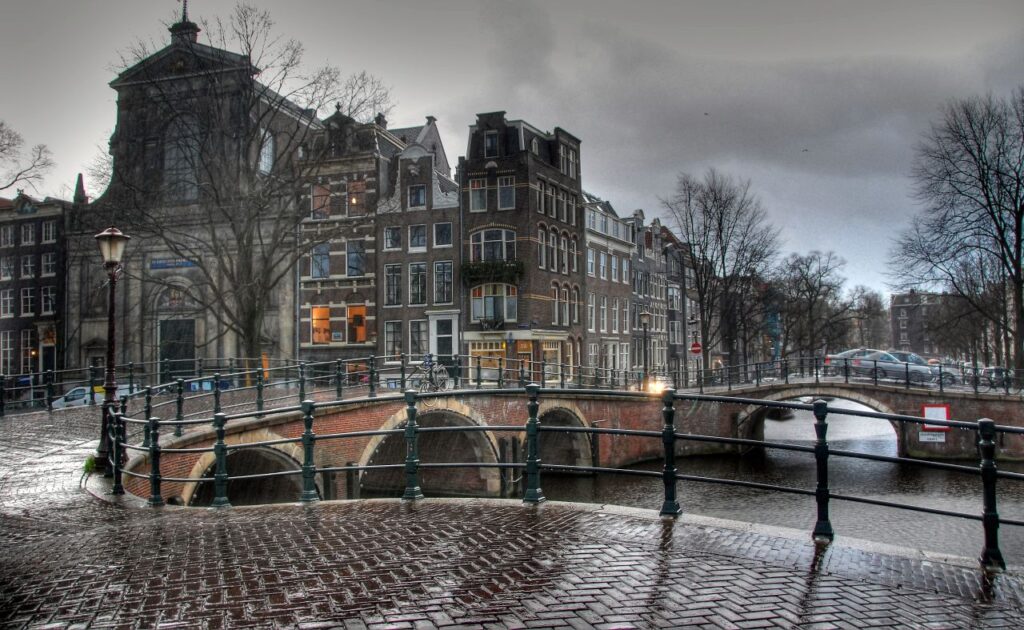
December
December is a festive month in Amsterdam despite the cold weather. With temperatures ranging from 3°C (37°F) to 7°C (45°F), the city is adorned with Christmas lights and markets, creating a magical atmosphere.
This guide provides a broad overview of what to expect when visiting Amsterdam. Remember, however, that these are average temperatures, and actual weather conditions can vary. Always check the forecast before your visit and pack accordingly.
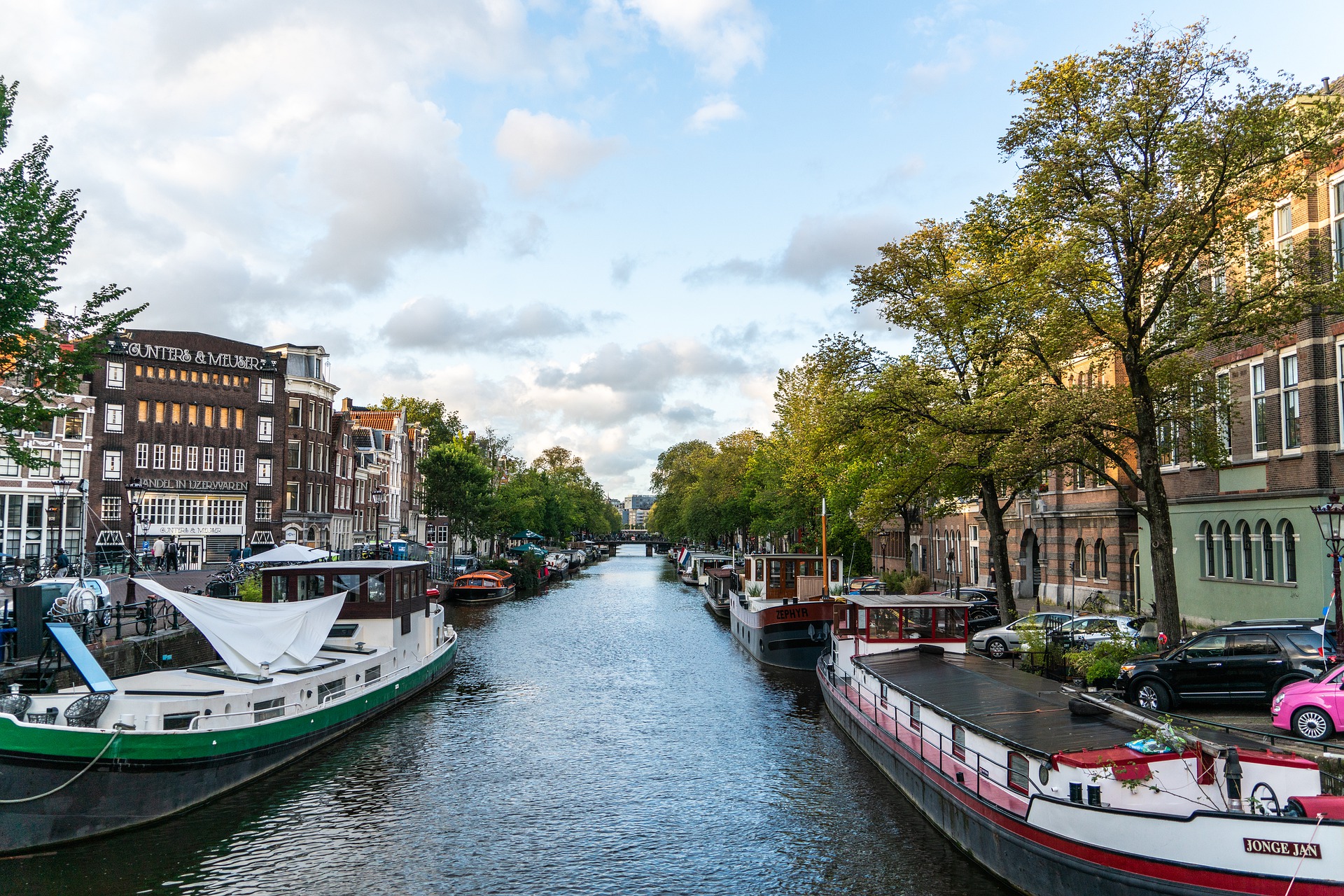
When planning a summer holiday to Amsterdam, understanding the weather patterns is crucial to make the most of your visit. This article outlines what to expect from Amsterdam weather in July, the perfect month for soaking up the Dutch sun and exploring this fascinating city’s unique attractions.
Amsterdam, the capital of the Netherlands, is a must-visit destination on many travelers’ European itineraries. Famous for its scenic canals, artistic heritage, and vibrant nightlife, the city becomes even more enticing in July when the weather is at its summer’s best.
Typically, Amsterdam in July experiences warm and pleasant temperatures. This time of the year is usually the warmest in this Dutch capital. Daytime temperatures typically range around 22°C (72°F), making it perfect for sightseeing, strolling around the charming city streets, or partaking in the numerous outdoor activities Amsterdam offers. Night-time temperatures are generally comfortable as well, averaging around 15°C (59°F).
Though, bear in mind that Amsterdam weather in July can sometimes surprise with sudden heatwaves, with temperatures soaring up to 30°C (86°F). Therefore, packing light, breathable clothing is essential for your Amsterdam summer trip.
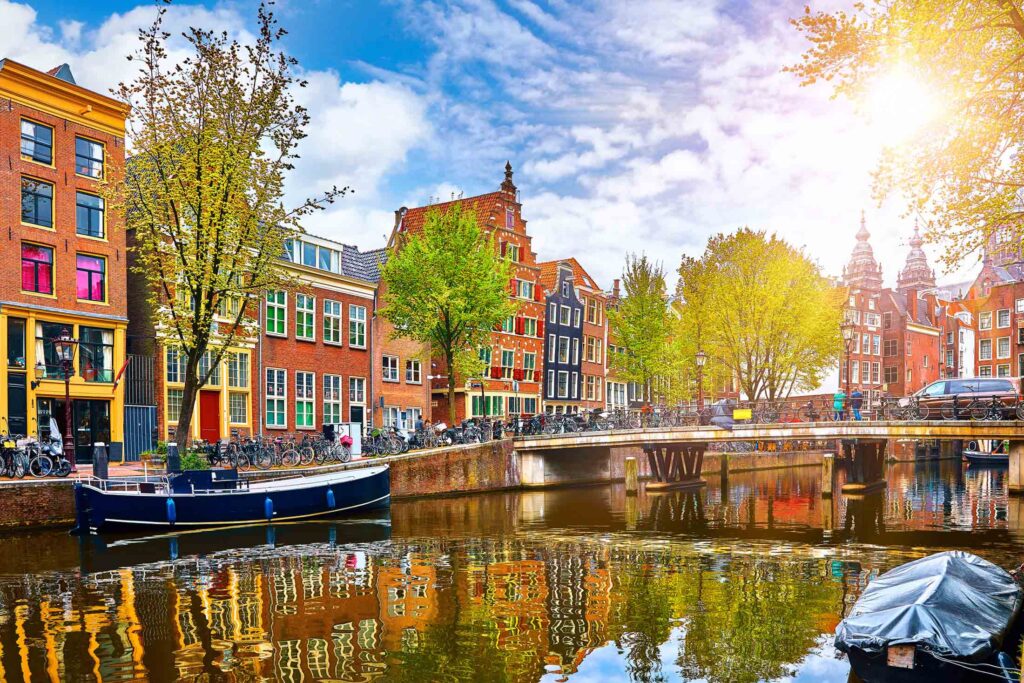
Rainfall in Amsterdam in July
Summer in Amsterdam isn’t just about sunshine and warmth. July falls within the Atlantic Hurricane Season, which implies a possibility of unpredictable weather patterns and sudden showers. On average, the city receives about 63mm of rain throughout July. This brings about a unique charm to the city, and it’s also why packing an umbrella or a light raincoat for your visit to Amsterdam in July can be a smart move.
Packing Essentials for July in Amsterdam
Daylight Hours in July in Amsterdam
One key benefit of visiting Amsterdam in July is the long daylight hours. Coming off the summer solstice in June, July enjoys up to 16 hours of daylight. This means you have ample time to visit landmarks like the Rijksmuseum, Anne Frank House, and the buzzing Jordaan district. It also provides the perfect setting for Amsterdam’s summer festivals and open-air events that happen in July.
In summary, the weather in Amsterdam in July provides a warm, inviting atmosphere for tourists, despite the occasional rain shower. The generous daylight hours offer ample opportunities for sightseeing and participating in outdoor events. Therefore, for anyone planning a trip to Europe, don’t miss out on Amsterdam in July, where you can experience pleasant summer weather and the city’s vibrant culture at its best.
Travel
Discovering the Best Things to Do in Amsterdam
Published
10 months agoon
30/06/2023By
Berry Fox
Discovering the Best Things to Do in Amsterdam. Amsterdam, the vibrant capital city of the Netherlands, is renowned for its picturesque canals, historic architecture, and a rich cultural heritage. From world-class museums and iconic landmarks to charming neighborhoods and a thriving culinary scene, this city has something for everyone. Whether you’re an art enthusiast, history buff, or simply seeking a unique travel experience, Amsterdam offers a plethora of exciting activities and attractions. In this article, we’ll explore some of the best things to do in Amsterdam, ensuring an unforgettable visit to this captivating city.
Discovering the Best Things to Do in Amsterdam
1. Explore the Museum District
Amsterdam’s Museum District is a treasure trove for art lovers. Start your cultural journey at the Rijksmuseum, home to masterpieces by Dutch masters such as Rembrandt and Vermeer. Don’t miss the awe-inspiring collection of Vincent van Gogh’s works at the Van Gogh Museum, and immerse yourself in contemporary art at the Stedelijk Museum. For a unique experience, visit the Moco Museum, which showcases modern and contemporary art, including works by Banksy.

2. Wander through the Historic Canal Ring
No visit to Amsterdam is complete without a leisurely stroll along the city’s enchanting canals. Recognized as a UNESCO World Heritage Site, the Canal Ring offers picturesque views, charming bridges, and delightful canal-side cafes. Consider taking a canal cruise to fully appreciate the city’s architectural gems and learn about its history. In spring, don’t miss the stunning display of colorful tulips blooming in the nearby Keukenhof Gardens.
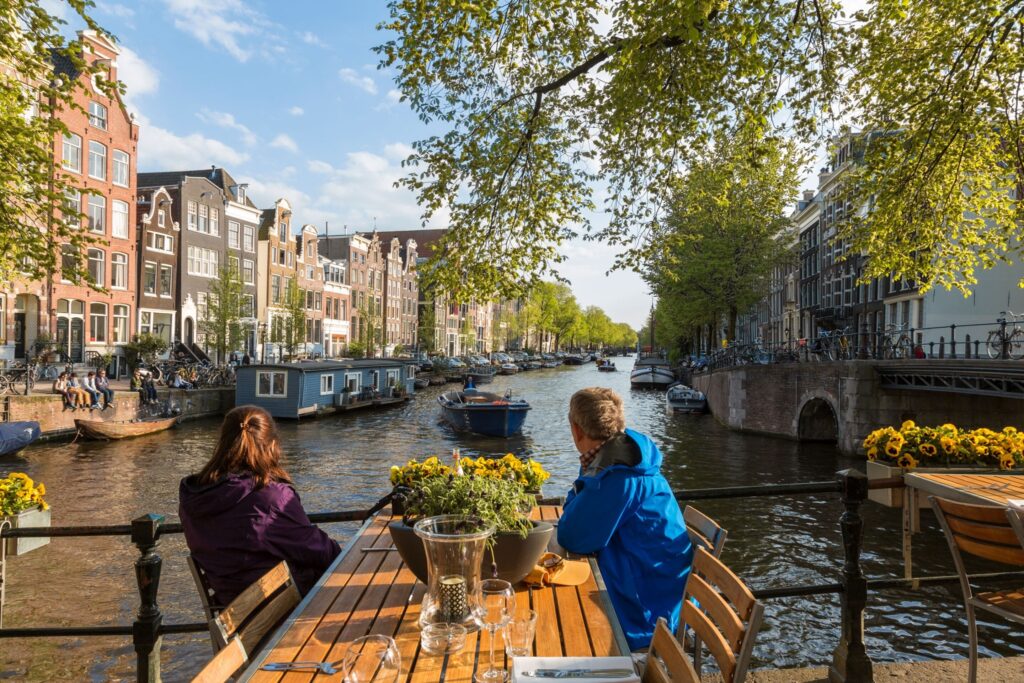
3. Experience the Anne Frank House
Step into the poignant history of World War II by visiting the Anne Frank House. Gain insight into the life of Anne Frank, a young Jewish girl who hid with her family during the Nazi occupation. The museum is located in the actual building where Anne wrote her famous diary, preserving the memory of those dark times. Be sure to book your tickets in advance, as it’s one of the most popular attractions in Amsterdam.

4. Indulge in the Local Cuisine
Amsterdam boasts a vibrant food scene, and tasting local delicacies is a must-do. Try traditional Dutch snacks such as herring, bitterballen (deep-fried meatballs), and stroopwafels (caramel-filled waffles). Explore the bustling Albert Cuyp Market to sample diverse street food, including Dutch cheeses, freshly baked stroopwafels, and mouthwatering pastries. For a unique dining experience, book a table at a “brown café” and savor hearty Dutch dishes alongside a locally brewed beer.

5. Visit the Vondelpark and Beyond
Escape the urban buzz and immerse yourself in nature at the serene Vondelpark, Amsterdam’s largest park. Stroll along its winding paths, rent a bike, or simply relax on the grass. If you’re a flower enthusiast, visit the Bloemenmarkt, the famous floating flower market, and admire the vibrant blooms. Additionally, take a short trip to the nearby Zaanse Schans, where you can explore traditional Dutch windmills and experience the charm of a bygone era.

6. Enjoy Nightlife and Entertainment
Amsterdam truly comes alive after dark, with a vibrant nightlife that caters to all tastes. Explore the lively neighborhood of Leidseplein, known for its bars, clubs, and live music venues. For a more alternative scene, head to the Jordaan district, which offers trendy bars and cozy cafés. Don’t miss the opportunity to witness a live performance at the Royal Concertgebouw or enjoy a comedy show at the famous Boom Chicago.

Amsterdam is a city that captivates visitors with its unique blend of history, culture, and vibrant atmosphere. From world-class museums and historic landmarks to picturesque canals and a thriving culinary scene, this Dutch capital offers an abundance of experiences for every traveler. By exploring the Museum District, wandering through the Canal Ring, visiting significant sites like the Anne Frank House, savoring local cuisine, immersing in nature, and enjoying the vibrant nightlife, you’ll uncover the true charm of Amsterdam and create memories that will last a lifetime.
Travel
Amsterdam’s Parking Prices: Tips for Budget-Friendly Parking
Published
10 months agoon
29/06/2023By
Berry Fox
How much are Amsterdam’s Parking Prices? Amsterdam, the picturesque capital city of the Netherlands, is known for its charming canals, historic architecture, and vibrant atmosphere. However, if you’re planning to explore this bustling city by car, it’s essential to be aware of the parking options and associated costs. In this article, we will delve into Amsterdam’s parking prices, offering valuable insights and tips to help you navigate the city’s parking landscape while keeping your budget in check.
Amsterdam’s Parking Prices: Tips for Budget-Friendly Parking
1. On-Street Parking:
Amsterdam provides on-street parking facilities throughout the city, but it’s important to note that rates and regulations can vary across different areas. The city is divided into zones, each with its own pricing structure. In general, parking rates in the city center tend to be higher than in the outskirts. It’s advisable to check the signage and pay attention to the color-coded parking signs, which indicate the applicable rates and restrictions for each area.

2. Paid Parking Zones:
To park in the city center and other busy areas, you will likely encounter paid parking zones. These zones are denoted by blue lines or signs with the letter “P” on a blue background. The cost of parking in these zones can range from €3 to €7 per hour, depending on the specific location and time of day. Additionally, some areas may have maximum parking durations, so be mindful of any restrictions to avoid fines.
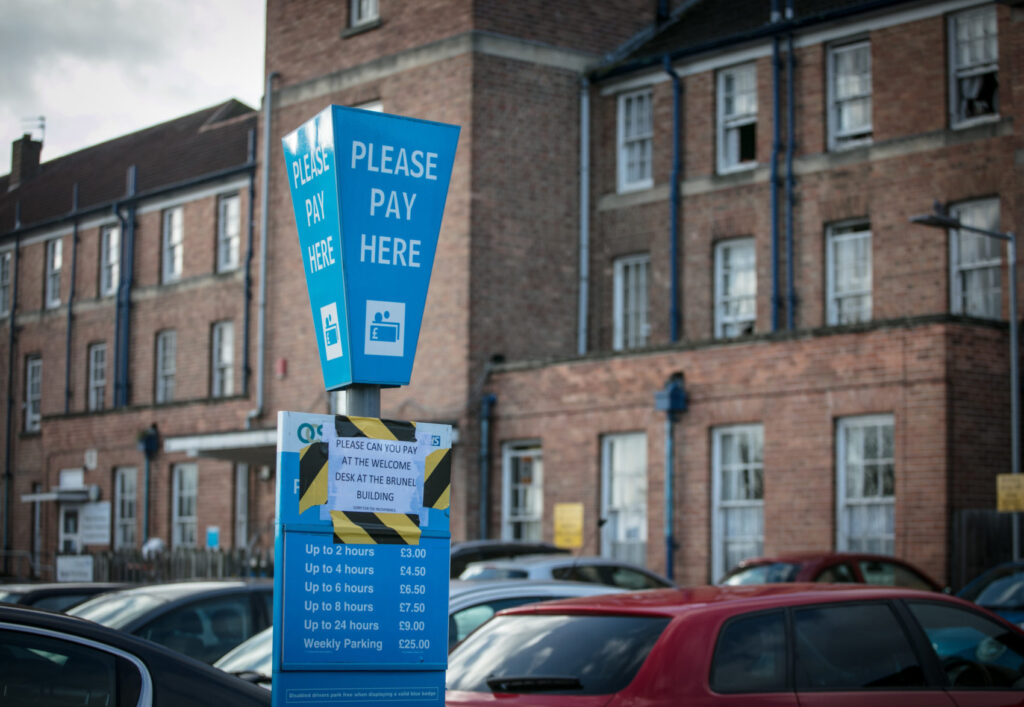
3. Parking Garages:
Amsterdam boasts a vast network of parking garages that provide a convenient alternative to on-street parking. Parking garages often offer fixed hourly rates or reduced rates for longer stays. While the rates may be higher than on-street parking, they provide the advantage of security and peace of mind. Popular parking garages can be found near major attractions, shopping districts, and transportation hubs. Utilizing these garages can save you time and provide a hassle-free parking experience.

4. P+R (Park and Ride) Facilities:
For those visiting Amsterdam and planning to drive into the city, the P+R facilities offer a cost-effective parking option. P+R facilities are strategically located on the outskirts of the city and provide affordable parking rates when combined with public transportation tickets. These facilities typically charge a flat fee of around €1 or €8 per day, depending on the location. It’s important to note that P+R rates are subject to specific rules and conditions, such as using public transport within a certain time frame.

5. Mobile Parking Apps:
To streamline your parking experience in Amsterdam, consider using mobile parking apps. These apps allow you to easily find available parking spaces, compare prices, and even pay for your parking session using your smartphone. Some popular parking apps in Amsterdam include Parkmobile, Yellowbrick, and ANWB Onderweg. By using these apps, you can conveniently manage your parking needs and potentially find discounted rates or special offers.

Amsterdam’s parking prices can be challenging to navigate, especially for visitors unfamiliar with the city’s parking regulations. By understanding the various parking options, paying attention to signage, and utilizing tools like parking apps, you can make informed decisions and optimize your parking experience. Remember to plan ahead, budget for parking costs, and explore alternatives such as P+R facilities to save money while enjoying the sights and attractions of this vibrant city. With a little preparation, you can ensure a smoother and more affordable parking experience during your time in Amsterdam.
Travel
Exploring the Charms of Amsterdam on a Memorable Day Trip
Published
10 months agoon
27/06/2023By
Berry Fox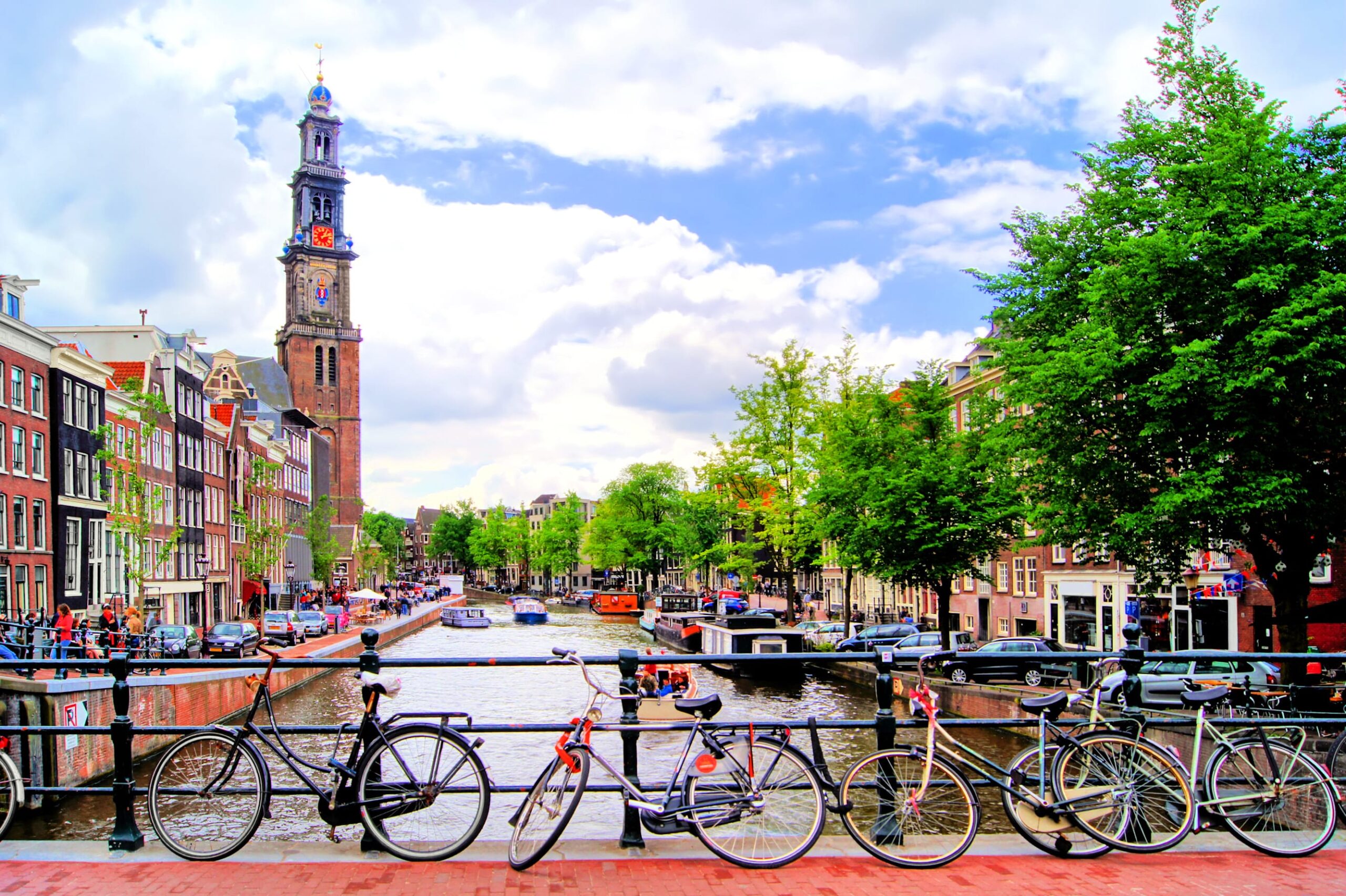
Amsterdam, the capital city of the Netherlands, is renowned for its picturesque canals, historic architecture, vibrant cultural scene, and a laid-back atmosphere that captures the hearts of travelers from around the world. While the city itself offers a multitude of attractions to explore, embarking on a day trip to Amsterdam presents a perfect opportunity to experience the essence of this charming city. Whether you’re a history buff, an art enthusiast, or simply seeking to soak in the unique Dutch ambiance, a day trip to Amsterdam is sure to leave you with unforgettable memories.
1.Canal Cruise: A Leisurely Introduction To truly appreciate the beauty and grandeur of Amsterdam, start your day trip with a relaxing canal cruise. Glide along the famous UNESCO-listed canals as you pass by elegant gabled houses, picturesque bridges, and bustling waterfronts. Absorb the enchanting scenery and gain insight into the city’s rich history and culture through informative commentary provided on most cruises. This leisurely introduction sets the stage for a day filled with exploration.

2. Historical Gems: Anne Frank House and Rijksmuseum No visit to Amsterdam would be complete without a visit to the Anne Frank House. Step into the poignant history of World War II as you enter the hiding place where Anne Frank penned her famous diary. Witness the preservation of the secret annex and immerse yourself in the personal story of the Frank family, providing a powerful reminder of the importance of tolerance and respect.

Next, head to the renowned Rijksmuseum, which houses a vast collection of Dutch art and history spanning several centuries. Marvel at masterpieces by Rembrandt, Vermeer, and other Dutch masters. The museum offers a glimpse into the nation’s cultural heritage and provides a fascinating exploration of Dutch art history.
3. Cultural Enclaves: Jordaan and Museumplein Take a stroll through the charming neighborhood of Jordaan, known for its narrow streets, picturesque canals, and quaint boutiques. Enjoy the delightful atmosphere as you explore the local shops, art galleries, and cozy cafes. Experience a taste of Dutch daily life and perhaps indulge in a traditional Dutch snack, such as a stroopwafel or herring.
Adjacent to Jordaan, visit Museumplein, a lively square home to several major museums, including the Van Gogh Museum and the Stedelijk Museum of modern and contemporary art. Admire the largest collection of Vincent van Gogh’s artworks in the world, and explore the diverse range of artistic expressions showcased in the Stedelijk Museum.
4. Vondelpark: Nature’s Oasis in the Heart of the City Escape the bustling city streets and find tranquility in Vondelpark, Amsterdam’s largest park. Nestled in the heart of the city, this lush green oasis offers a serene retreat for locals and visitors alike. Take a leisurely stroll or rent a bike to explore the park’s winding paths, picturesque ponds, and beautifully landscaped gardens. Enjoy a picnic on the grass or simply relax and soak up the peaceful ambiance.

5. Culinary Delights: Dutch Cuisine and Canalside Dining No visit to Amsterdam is complete without indulging in the city’s culinary delights. From street food to Michelin-starred restaurants, Amsterdam offers a diverse range of options to satisfy every palate. Sample traditional Dutch dishes such as bitterballen (deep-fried meatballs) or stroopwafels (syrup-filled waffles) at local food stalls or venture into a charming canalside restaurant for a leisurely lunch or dinner, accompanied by beautiful canal views.
A day trip to Amsterdam is a fantastic way to immerse yourself in the city’s rich history, art, and culture. From exploring the poignant Anne Frank House to admiring world-class art at the Rijksmuseum, and from strolling through charming neighborhoods to finding solace in the peaceful Vondelpark, Amsterdam offers an array of experiences that will leave you captivated. So, pack your curiosity and embark on a memorable day trip to discover the captivating charm of Amsterdam.
Travel
Discover the Best Swimming Spots in the Netherlands
Published
10 months agoon
25/06/2023By
Berry Fox
The Netherlands, known for its picturesque canals, windmills, and tulip fields, also offers a variety of delightful swimming spots. Despite being a relatively small country, the Netherlands boasts numerous lakes, rivers, and coastal areas that provide excellent opportunities for a refreshing swim. In this article, we will explore some of the best places to swim in the Netherlands, offering a mix of natural beauty and tranquil surroundings.
Discover the Best Swimming Spots in the Netherlands
1. Zandvoort Beach
Located just a short distance from Amsterdam, Zandvoort Beach is one of the most popular coastal destinations for locals and tourists alike. With its wide stretch of sandy shore, clear blue waters, and lively beach clubs, Zandvoort offers the perfect combination of relaxation and entertainment. Take a dip in the North Sea, bask in the sun, and enjoy beachside amenities, making it an ideal spot for a day trip or a weekend getaway.
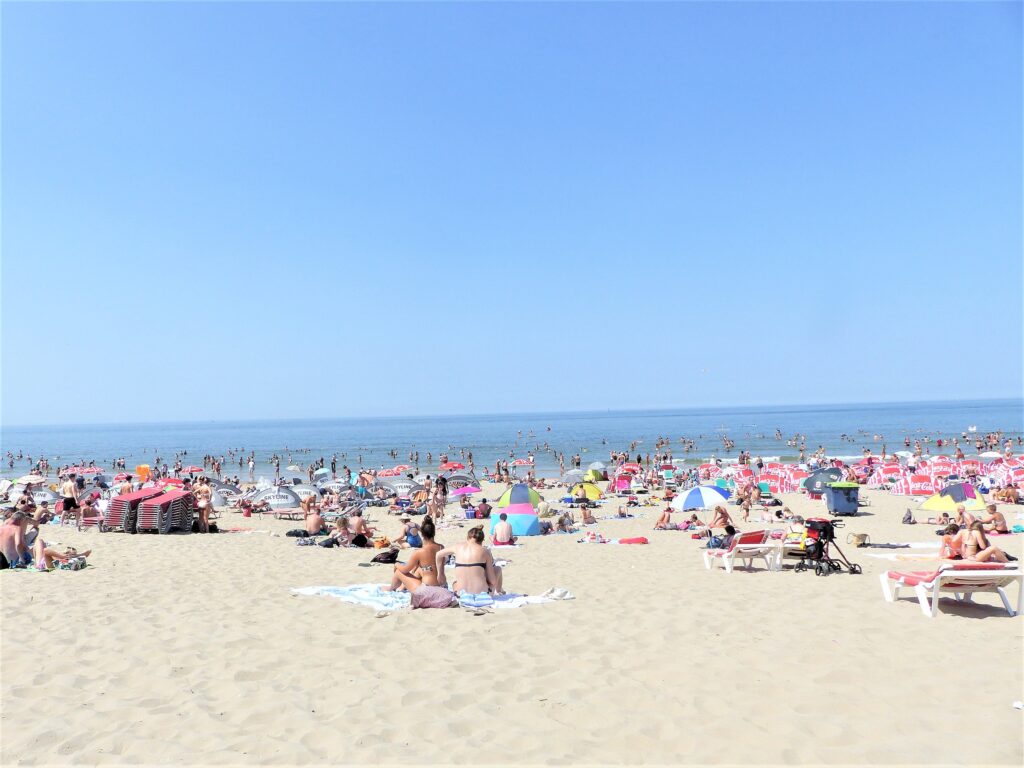
2. Henschotermeer
For those looking to escape the bustling cities, Henschotermeer is a hidden gem located near the town of Woudenberg in the Utrechtse Heuvelrug National Park. This pristine lake, encompassed by dense forests and rolling hills, provides a serene environment for swimming enthusiasts. The crystal-clear waters and sandy beaches create a postcard-worthy setting, perfect for unwinding and immersing oneself in nature.

3. Binnenschelde
Situated in the province of Zeeland, Binnenschelde is an artificial lake created from a former sand extraction site. Today, it has transformed into a vibrant recreational area offering a range of water activities, including swimming, windsurfing, and sailing. The lake’s clean waters, complemented by its landscaped beaches and lush greenery, make Binnenschelde a fantastic spot for water sports enthusiasts and families alike.
4. The Vinkeveense Plassen
Located in the province of Utrecht, the Vinkeveense Plassen is a network of interconnected lakes, making it an aquatic paradise. Known for its clear waters and diverse marine life, this area is particularly popular among scuba divers and snorkelers. However, visitors can also enjoy swimming in designated areas while taking in the scenic beauty of the surrounding reed beds and picturesque islands.

5. Veluwemeer
Nestled in the heart of the Netherlands, Veluwemeer is a large lake situated between the provinces of Gelderland and Flevoland. Its extensive coastline, dotted with sandy beaches and lush green areas, offers an inviting atmosphere for swimming, sunbathing, and picnicking. The lake’s calm waters are well-suited for families and those seeking a peaceful retreat amidst stunning natural surroundings.

The Netherlands may not be the first country that comes to mind when thinking about swimming destinations, but it offers a surprising array of enchanting spots for aquatic enthusiasts. From sandy beaches along the coast to serene lakes nestled in idyllic settings, the country has something to suit every swimmer’s taste. Whether you seek a refreshing dip or a relaxing day in nature, these swimming spots in the Netherlands are sure to provide a memorable experience for visitors and locals alike. So, pack your swimsuit and dive into the tranquil waters of the Netherlands for an unforgettable aquatic adventure.
Travel
Exploring Amsterdam: A Guide to Must-Do Activities and Attractions
Published
10 months agoon
15/06/2023By
Berry Fox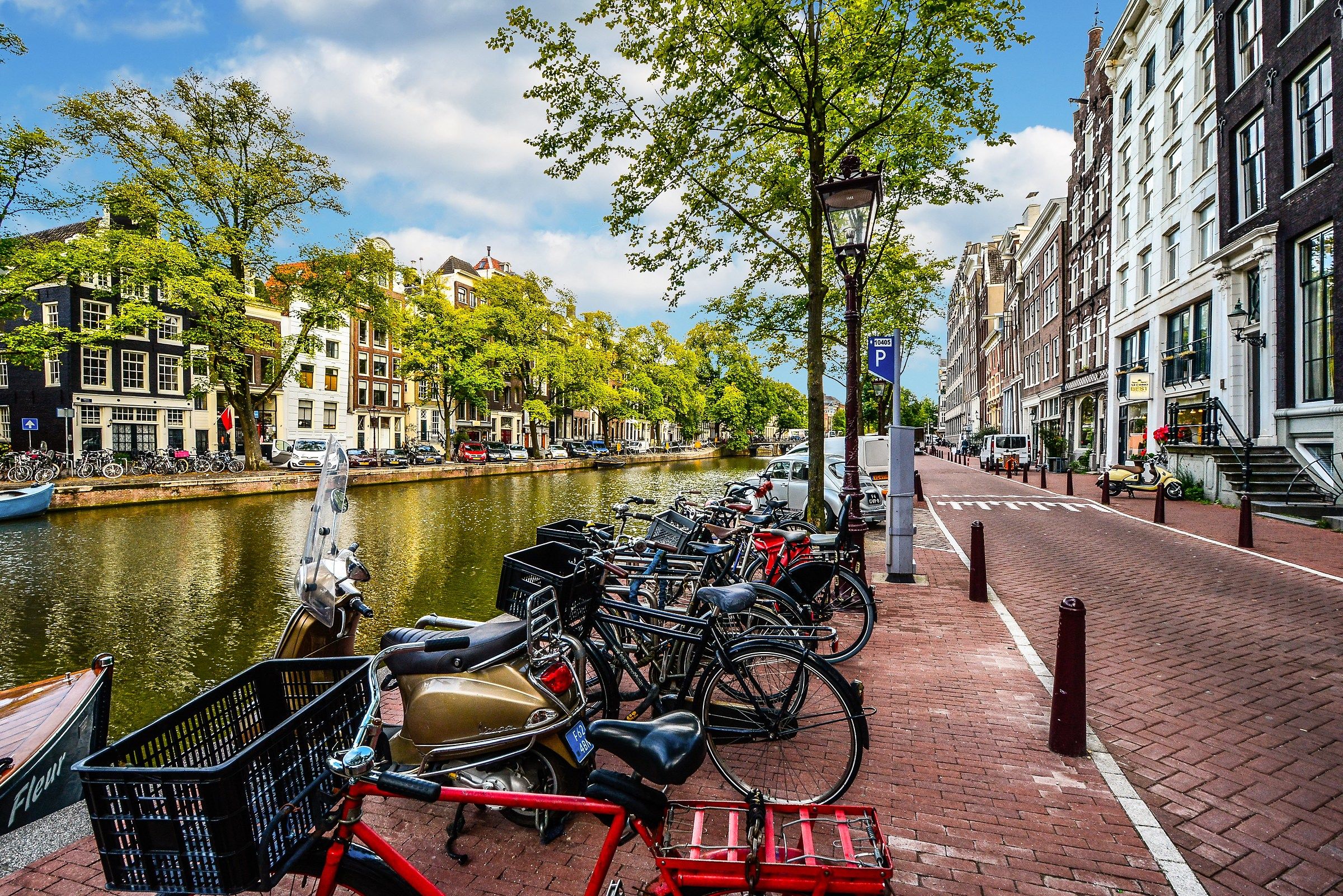
Amsterdam, the capital city of the Netherlands, is a vibrant and diverse destination that offers a plethora of activities and attractions to suit every traveler’s interests. From its enchanting canals and historic architecture to its world-class museums and vibrant nightlife, Amsterdam is a city that truly has something for everyone. Whether you’re a history buff, an art enthusiast, a foodie, or simply someone looking to soak up the unique atmosphere, here’s a guide to the top things to do and see in Amsterdam.
What things to do in Amsterdam?
1. Cruise the Picturesque Canals
One of the best ways to experience the charm of Amsterdam is by taking a canal cruise. Hop on a boat and navigate the UNESCO-listed canals, marveling at the elegant canal houses, quaint bridges, and picturesque views. You can choose from various types of cruises, including hop-on-hop-off options, romantic candlelit tours, or even guided tours that provide insight into the city’s history and architecture.

2. Visit the Van Gogh Museum
Art enthusiasts cannot miss the opportunity to visit the renowned Van Gogh Museum. This world-class institution houses the largest collection of works by the legendary Dutch artist, Vincent van Gogh. Immerse yourself in his masterpieces, including “The Starry Night” and “Sunflowers,” and gain a deeper understanding of the artist’s life and artistic journey through the museum’s comprehensive exhibitions.

3. Explore the Anne Frank House
For a poignant and thought-provoking experience, visit the Anne Frank House. Step into the secret annex where Anne Frank and her family hid during World War II, and gain insight into their extraordinary story through exhibits and personal artifacts. The museum serves as a powerful reminder of the impact of intolerance and the importance of human rights.

4. Discover the Historic City Center
Amsterdam’s historic city center, known as the Canal Ring, is a UNESCO World Heritage site and a treasure trove of architectural wonders. Take a leisurely stroll or rent a bike to explore the narrow streets, charming squares, and beautiful buildings. Don’t miss the iconic Dam Square, home to the Royal Palace, or the bustling market at the Bloemenmarkt, where you can find a stunning array of flowers.
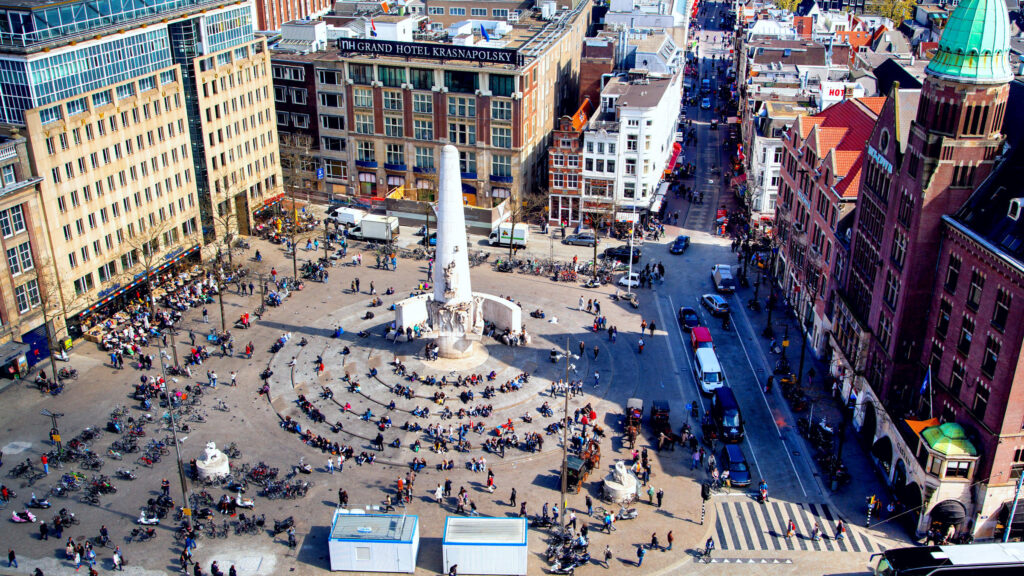
5. Indulge in Dutch Cuisine
Amsterdam is a food lover’s paradise, offering a wide range of culinary delights. Sample traditional Dutch treats such as stroopwafels (caramel-filled waffles) and herring from street vendors. For a unique dining experience, try rijsttafel, a colonial Indonesian feast featuring a variety of small dishes. Additionally, explore the city’s thriving food scene with its numerous cafes, restaurants, and trendy food markets.

6. Immerse Yourself in Art at the Rijksmuseum
Another must-visit museum in Amsterdam is the Rijksmuseum, which houses an extensive collection of Dutch art and history. Admire masterpieces by the likes of Rembrandt, Vermeer, and Frans Hals, among others. The museum’s highlights include Rembrandt’s “The Night Watch” and the exquisite collection of Delftware ceramics.

7. Enjoy the Vibrant Nightlife
As the sun sets, Amsterdam’s vibrant nightlife comes alive. From lively bars and cozy pubs to trendy nightclubs, the city offers entertainment options for all tastes. Visit the popular Leidseplein or Rembrandtplein squares, which are lined with bars and clubs, or explore the trendy Jordaan neighborhood, known for its eclectic mix of venues.

8. Visit the Keukenhof Gardens (Seasonal)
If you’re visiting Amsterdam during spring (mid-March to mid-May), a visit to the nearby Keuken
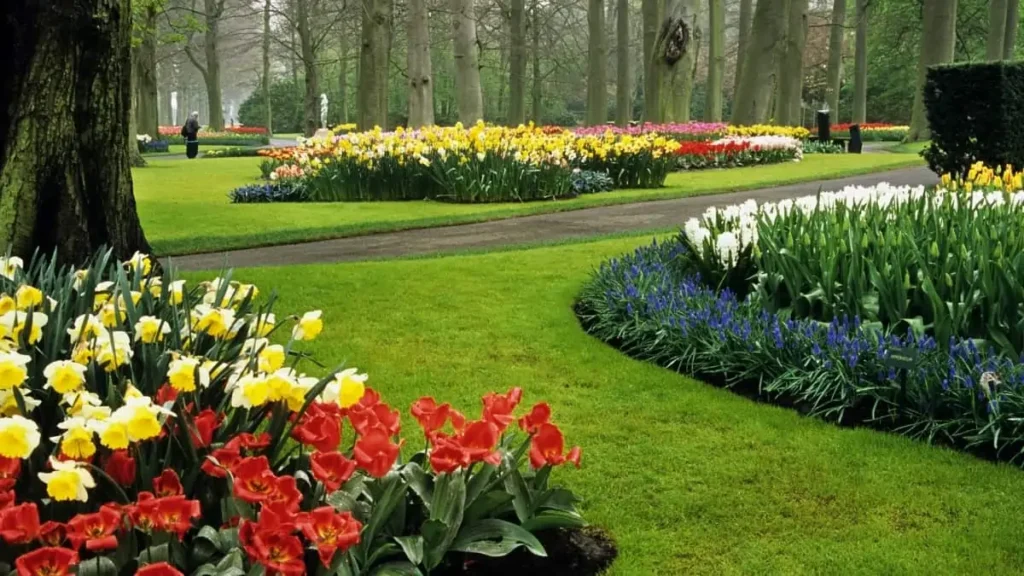
Travel
Amsterdam Weather: A Delightful Blend of Seasons
Published
10 months agoon
14/06/2023By
Berry Fox
Amsterdam, the vibrant capital city of the Netherlands, is known for its rich history, picturesque canals, and diverse culture. One of the aspects that adds to the charm of this beautiful city is its ever-changing weather. From misty mornings along the canals to sunny afternoons in the parks, Amsterdam offers a delightful blend of seasons throughout the year. In this article, we will explore the different seasons and weather patterns that grace the streets of Amsterdam.
Spring: Awakening from Winter’s Embrace
As winter fades away, Amsterdam comes alive with the vibrant colors of spring. From March to May, the city experiences a refreshing change in weather, with average temperatures ranging from 8 to 15 degrees Celsius (46 to 59 degrees Fahrenheit). While mornings and evenings may still be chilly, the afternoons witness a gradual increase in warmth. Spring showers are common, so it’s wise to carry an umbrella or raincoat while exploring the city’s beautiful parks, such as Vondelpark or Keukenhof Gardens, where blooming tulips create a mesmerizing spectacle.

Summer: Sunny Days and Festive Vibes
Summer in Amsterdam is a joyous time, with long days filled with sunshine and an array of festivals and outdoor activities. From June to August, temperatures range from 15 to 25 degrees Celsius (59 to 77 degrees Fahrenheit), making it ideal for exploring the city’s famous museums, strolling along the canals, or simply relaxing in one of the many outdoor cafes. The warm weather invites locals and tourists alike to enjoy boat tours along the canals or picnics in parks like Westerpark or Oosterpark. It’s important to note that summer rainfall is not uncommon, so packing a light jacket or umbrella is still a good idea.

Autumn: A Tapestry of Colors
Autumn paints Amsterdam in a stunning tapestry of colors, as the leaves turn golden and the city prepares for a cooler season. From September to November, temperatures range from 10 to 15 degrees Celsius (50 to 59 degrees Fahrenheit). As the days gradually become shorter, Amsterdam experiences more rain showers and cooler breezes. Nevertheless, the city remains captivating, with its historical buildings reflected in puddles and cozy cafes offering warm drinks to combat the chill. The autumnal charm is best enjoyed by taking a leisurely stroll through the Jordaan neighborhood or exploring the nearby countryside, such as Zaanse Schans or the beautiful Amsterdamse Bos.

Winter: A Winter Wonderland
Amsterdam transforms into a winter wonderland during the colder months. From December to February, temperatures range from 0 to 8 degrees Celsius (32 to 46 degrees Fahrenheit), and the city often experiences snowfall, creating a picturesque scene. The canals freeze over, and locals and visitors eagerly lace up their ice skates for a quintessential Dutch experience. The festive season brings a delightful atmosphere, with Christmas markets, ice sculptures, and cozy cafes serving warm beverages and delicious Dutch treats like oliebollen. The city’s museums and galleries also provide a haven for indoor exploration during this season.

Amsterdam’s weather showcases a unique blend of seasons, each offering its own distinct charm and opportunities for exploration. Whether you’re admiring the blooming tulips in spring, basking in the sunshine during summer, marveling at the autumn foliage, or experiencing a winter wonderland, Amsterdam’s weather adds to the city’s allure. So, no matter the time of year, be prepared for changing conditions and embrace the beauty that each season brings while enjoying all that Amsterdam has to offer.

Major disruption in train services between Rotterdam and Den Haag until December

More than 800 film producers and actors in the Netherlands call for sanctions against Israel

Scientists warn: Ultra-processed food is as addictive as cigarettes

The price of a pack of cigarettes in Belgium will be 10 euros

There will also be an increase in the consumption tax on soft drinks in the Netherlands

Wanted murder suspect Bretty Dorder in the Netherlands was caught!

Fighting dog feces: Tracing feces with DNA

Ajax – Feyenoord: 0-4 (MATCH RESULT)

Armed attack in Rotterdam, Netherlands: 3 dead

Home Ownership Rate Declines in European Union Countries

Van Gogh’s stolen painting was found after 3.5 years

Pakistani cricketer who put a bounty on Geert Wilders’ head gets 12 years in prison

Fossil fuel protest in the Netherlands on the second day: 500 activists detained

Ajax-Feyenoord derby canceled due to incidents

Bicycles in Amsterdam: The Art of Commuting

Amsterdam’s Cycling Culture: A Lifestyle to Embrace

Amsterdam’s Bike-Friendly Neighborhoods

The Wheel Revolution: How Amsterdam’s Bicycles Reshaped the Cityscape

How to eat cheap food in Amsterdam?

Arts and Entertainment: Amsterdam Guide 2023

Heartbeat of Amsterdam: Exploring the Iconic Bicycles

How to Rent a Bike in Amsterdam

Billboards of OnlyFans model spark controversy in UK

Dutch Supreme Court: Israeli soldiers cannot be tried in our country

Amsterdam fine for loud car engines and exhausts

Verstappen equals F1 record

Exploring Amsterdam’s Best Laptop-Friendly Cafés for Digital Nomads

How Netherlands Emergency system works?

2 Russian warplanes approaching Dutch airspace intercepted

In another city in the Netherlands, a bacteria warning was issued in drinking water

Warning from TK Maxx in the Netherlands: Electric leakage in the adapters!

Rising rents in the Netherlands led citizens to Belgium

Children’s bicycle helmets are recalled for safety reasons in the Netherlands

Train tickets increase by 6.6 percent in the Netherlands

Mother and son missing for 2 months in the Netherlands still not found

The sweltering heat is coming in the Netherlands

‘Netherlands’ Stonehenge’ Discovered: 4000-Year-Old Graveyard and Glass Beads From Mesopotamia Found

Large cruise ships banned in Amsterdam seeking to reduce tourist numbers

Ship loaded with vehicles burning off the Dutch coast for 2 days raises environmental disaster concerns






